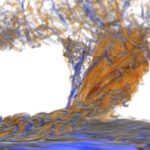“What makes this work significant is the use of supercomputing resources to produce simulations of supercells where data is saved with extremely high spatial and temporal resolution, and the use of visualization techniques (such as volume rendering and trajectory clouds) to produce video that exposes the highly variable flow features that occur throughout the life of the simulated storms. Some of these simulations contain long lived tornadoes producing near-surface winds exceeding 300 mph.”
Supercomputing Tornadogenesis
“We’re trying to make high resolution simulations of super cell storms, or tornadoes,” McGovern said. “What we get with the simulations are the fundamental variables of whatever our resolution is — we’ve been doing 100 meter x 100 meter cubes — there’s no way you can get that kind of data without doing simulations. We’re getting the fundamental variables like pressure, temperature and wind, and we’re doing that for a lot of storms, some of which will generate tornadoes and some that won’t. The idea is to do data mining and visualization to figure out what the difference is between the two.”





